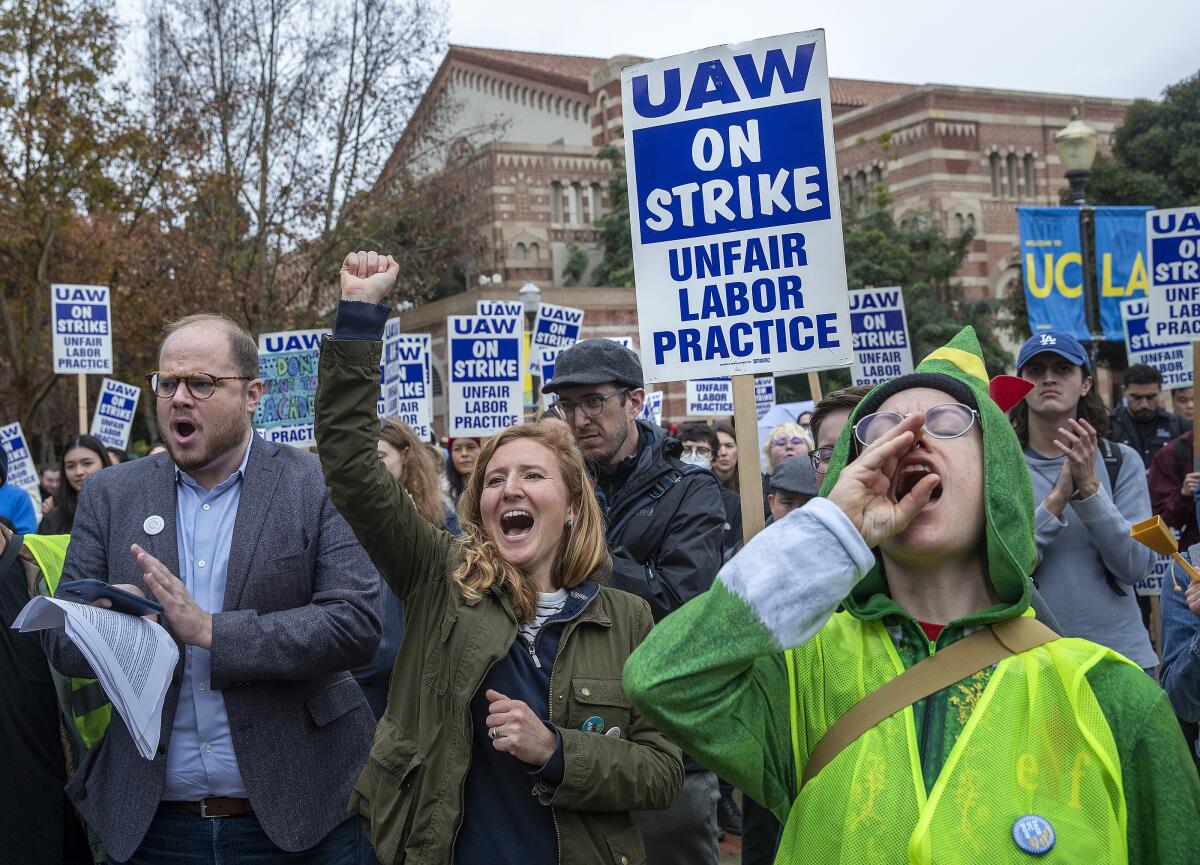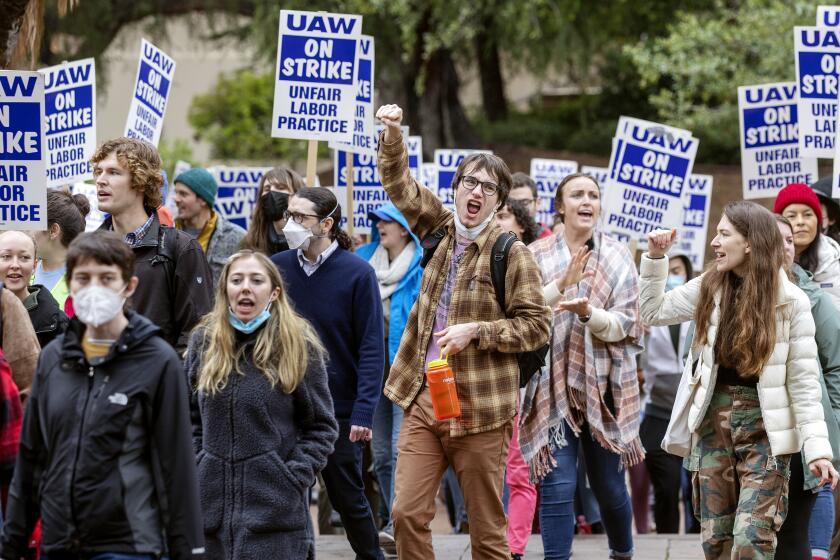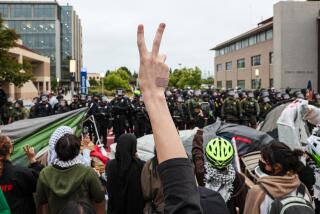UC strike energizes unprecedented national surge of union organizing by academic workers

- Share via
Piril Nergis is a doctoral student at USC but joined picket lines at UCLA to support the recent strike of University of California academic workers. Solidarity trumped crosstown rivalry in what Nergis said was an electrifying experience that helped fire up union organizing efforts among USC’s own graduate students.
Sam Ponnada, a doctoral candidate helping organize a union at Caltech, was surprised by an unexpected campus decision last month to increase graduate student stipends by 17% — a major raise the university said was an independent decision, but “several of us can’t help but notice ... happened right after the big UC strike,” he said.
And at the Rand Corp.’s graduate school in Santa Monica, David DeSmet said he and fellow doctoral students were inspired to organize with the United Auto Workers after reading about UC graduate student researchers forming their first union and winning “really dang good” wage gains.
The UC strike is over, culminating last month in significant improvements in wages and working conditions after 48,000 teaching assistants, tutors, researchers and postdoctoral scholars walked off their jobs in the nation’s largest labor action of academic workers. But the effects of the historic strike still reverberate across the nation, helping energize an unprecedented surge of union activism among academic workers that could reshape the teaching and research enterprise of American higher education.
In 2022 alone, graduate students representing 30,000 peers at nearly a dozen institutions filed documents with the National Labor Relations Board for a union election. They include USC, Northwestern, Yale, Johns Hopkins, the University of Chicago, Boston University and the Massachusetts Institute of Technology. Caltech plans to officially kick off its organizing campaign this month, and other academic researchers are working to form unions at the University of Alaska, Western Washington University, the National Institutes of Health and such influential think tanks as the Brookings Institution and Urban Institute.
A confluence of several factors has propelled the burst of labor activism: disaffection with rising inflation, unaffordable housing, limited healthcare, growing student debt, university treatment of academic workers during the pandemic, and a more union-friendly Biden administration. But students and labor experts also point to the influence of the UC strike, which drew national attention by marshaling four UAW bargaining units on all 10 campuses and the Lawrence Berkeley National Laboratory to pull off a massive walkout that shut down classes, suspended research, roiled finals and upended grading — ultimately winning some of the largest wage gains ever secured by academic workers.
University of California graduate student workers ratified a new labor agreement that will boost wages by up to 80%, ending a historic strike that upended fall term finals and grading.
“Once you see a university system this large come together and demand livable wages, better benefits ... then you’re going to see it across the nation,” said Melissa Atkins, a labor and employment partner at Obermayer Rebmann Maxwell & Hippel. “It’s going to be just a ripple effect of university grad students wanting what California obtained.”
UC academic workers ended their six-week strike Dec. 23 after scoring groundbreaking protections against bullying and harassment, financial support for child care, dependent healthcare for certain eligible workers and what the majority of union members regard as significant wage gains.
For academic student employees in UAW 2865, the new contract will raise minimum pay from about $23,250 to about $34,000 for nine months of part-time work by Oct. 1, 2024. The rate at UC Berkeley, UC San Francisco and UCLA would be $36,500, a distinction criticized as inequitable by some union members, but justified by supporters to account for the high cost of living in these cities and higher pay needed to compete for top talent.

Subscribers get exclusive access to this story
We’re offering L.A. Times subscribers special access to our best journalism. Thank you for your support.
Explore more Subscriber Exclusive content.
Graduate student researchers in SRU-UAW would make a minimum of $34,564.50 for nine months of part-time work by Oct. 1, 2024, under a new six-point salary scale. Postdoctoral scholars and academic researchers in UAW 5810 boosted their minimum pay to $70,000 with adjustments, among the highest in the nation.
Those wage gains have upped the ante among universities that fiercely compete for the best research talent. At the University of Washington, campus negotiators in November made an opening offer to significantly raise the minimum pay for postdoctoral workers to about $65,000 from the current $53,760. A campus spokesman said the offer was not related to the UC strike, but a UW union leader said the California system’s labor action has been important in other ways.
“I can’t say for sure whether admin made that proposal because of the UC strike, but we certainly don’t think it’s a coincidence,” Sam Sumpter, president of the UW academic worker union, UAW 4121, said in an email. “And I can definitely say that our members are paying attention to what UC academic workers have been able to achieve, and are taking a lot of inspiration from it.”
Caltech announced last month that it would increase graduate student stipends from a minimum $38,500 to $41,000 for 2022-23 and to $45,000 for 2023-24.
“We believe that these adjustments will allow our students to manage their local expenses without undue financial stress, and ... will position Caltech well to attract the most talented graduate students who will be recruited aggressively by our peers,” Provost David A. Tirrell and Dean of Graduate Studies David C. Chan told faculty in the Dec. 15 email.
The raises reflect “the results of a thoughtful dialogue with graduate student leadership based on costs of attendance specific to Pasadena, independent of other events,” said Shayna Chabner McKinney, a university spokesperson.
Last year, Princeton University announced a 25% increase in graduate student stipends, the largest one-year raise ever offered, to a range of $38,000 to $42,000 — just after academic workers ended a 10-week strike at Columbia and as union organizing took off at MIT.
The University of Pennsylvania also announced its largest one-year increase ever in minimum doctoral stipends — 24% to $38,000 — beginning in 2023-24. Both Princeton and Penn also cited the need to remain competitive in the race to recruit top research talent.
“These big actions in higher ed don’t just raise the bar for those institutions; they raise the bar everywhere for all grad students and postdocs,” said Ponnada, the Caltech graduate student researcher in astrophysics. “It’s kind of forcing a race to the top ... to match the better pay, benefits and workplace conditions that academic unions are winning across the country.”
Obstacles to university union campaigns
Academic workers have been trying to organize for decades but have been stymied by regulations and politics over the contentious issue of whether they are primarily students whose teaching and research work are part of their academic pursuits or employees with the right to form unions and bargain collectively.
Workers at public universities have had an easier time organizing, with UC’s sheer size making it a leader in the effort. Teaching assistants at the University of Wisconsin–Madison were the first to win recognition as an independent employee bargaining unit in 1969.
After resisting academic worker unions for years, UC accepted the first one in 1999 after a systemwide strike of teaching assistants, tutors and readers demanding recognition. A year later, UC negotiated the first contract with what became the nation’s largest bargaining unit of academic workers — a “watershed moment” involving more than 9,000 graduate students at the time, said Mike Miller, a former UCLA graduate student worker who now serves as UAW director for several western states.
UC academic workers formed the nation’s first postdoctoral employee union in 2008, and student graduate researchers finally secured their own bargaining unit in 2021.
But the battle has been tougher among private colleges and universities, whose organizing efforts are overseen by the National Labor Relations Board — and affected by the political leanings of the U.S. president who appoints the members. The board under Democratic President Clinton was the first to declare that academic workers in private institutions were employees with collective bargaining rights in a 2000 case involving New York University.
But Republican George W. Bush’s appointees reversed that ruling, which was later reversed under Democrat Barack Obama. Republican Donald Trump’s board sought to reinstate earlier rulings that academic workers weren’t employees with the right to unionize. President Biden withdrew the Trump board’s proposed action in 2021.
Kate Bronfenbrenner, Cornell University’s director of labor education research and a senior lecturer, said moves to cut costs at many universities have shifted a greater share of teaching and research to graduate students — placing them in the role of employees who should be able to raise their collective voice for better pay and working conditions. Even if a Republican wins the White House in 2024, she said, the unionization drive would probably continue to surge — but academic workers would have to fight harder for enforcement of their contracts.
Pandemic pushed union efforts
Bronfenbrenner said the pandemic exacerbated disaffection among academic workers, especially those forced into risky working conditions without much recourse to push back. Graduate students, for example, were asked to teach in-person classes or work in labs before major campus closures took effect, even if they felt uncomfortable doing so.
“There is no question that COVID was a tipping point,” Bronfenbrenner said. “That combination of low wages and suddenly risking serious health conditions when you went to work spurred the organizing. Workers put up with a lot, but they don’t come to work to die.”
The Cornell labor expert added that a generational shift may also be fueling the labor activism. Fully 77% of young people between the ages of 18 and 34 support unions — the largest level of support among all age demographics, according to a 2021 Gallup Poll.
“A lot of us millennials do see the worsening working conditions,” said DeSmet, the doctoral student at the Pardee Rand Graduate School, who is working on renewable energy and climate change. “Collective bargaining seems to a lot of us the most effective tool to make sure we have a future.”
Ruby Byrne, a postdoctoral scholar in astronomy at Caltech, experienced the power of collective bargaining as a graduate student at the University of Washington. Academic worker unions there have secured strong wages and a generous healthcare plan. When she came to Caltech in 2021, she said, the inferior benefits were disappointing — and helped spur her to step up to organize scholars.
“None of us are in this for the money. We are very passionate about the science that we’re doing,” Byrne said. “But there’s a problem when folks who are in our position, who are doing this really cutting-edge research at a very high level with training and professional certifications that we have, are still struggling to make ends meet.”
That is one way the academic labor movement is growing — workers who experience benefits at one campus move to another without them and take action, said Maggie Davis, a USC doctoral student in political sociology and social theory. USC union organizers saw that firsthand when they joined the picket line at UCLA.
“They’re really reminding us that we are something bigger than ourselves,” Davis said of UC union members. “The momentum is really, really alive right now.”
More to Read
Sign up for Essential California
The most important California stories and recommendations in your inbox every morning.
You may occasionally receive promotional content from the Los Angeles Times.












